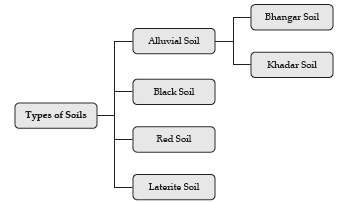Students should refer to Soil Resources ICSE Class 10 Geography notes provided below designed based on the latest syllabus and examination pattern issued by ICSE. These revision notes are really useful and will help you to learn all the important and difficult topics. These notes will also be very useful if you use them to revise just before your Geography Exams. Refer to more ICSE Class 10 Geography Notes for better preparation.
ICSE Class 10 Geography Soil Resources Revision Notes
Students can refer to the quick revision notes prepared for Chapter Soil Resources in Class 10 ICSE. These notes will be really helpful for the students giving the Geography exam in ICSE Class 10. Our teachers have prepared these concept notes based on the latest ICSE syllabus and ICSE books issued for the current academic year. Please refer to Chapter wise notes for ICSE Class 10 Geography provided on our website.
Soil Resources ICSE Class 10 Geography
Soil Resources ICSE Class 10 Geography Notes
TOPIC-1
Types of Soil, Composition and Its Characteristics
Quick Review
➢ Soil is the main layer of loose mixture of small rock particles and decaying organic matter that covers the land surface.
➢ Different sources of nature like changing temperature, running water and wind affect the formation of soil.
➢ Soil is derived from parent rock material through a process of breakup or wear and tear.
➢ Humus (decomposed vegetal and animal remains) is the main constituent of soil. Silica, clay and sand are also other constituents of soil.
➢ Soil fertility refers to the nutrients present in the soil to support plant life.
➢ The important features of soil fertility is that it contains adequate amount of moisture, is rich in nutrients like nitrogen, phosphorous and potassium (NPK), contains organic matter and has sufficient depth to enable the plants to grow roots.
➢ Depending on the location, soil can be categorized into- Residual or Sedimentary Soil and Transported Soil.
➢ Residual soil are formed ‘in-situ’ that is formed in their original position by the breaking up of parent rocks, e.g. Black Soil, Red soil, Laterite Soil, Desert Soil etc.
➢ Soils that are transported through various agents of soil erosion like wind and running water, e.g. Alluvial
Soil.
➢ Soils are classified into the following types- Alluvial Soils, Black Soils, Red Soils and Laterite Soils.


Know the terms
➢ Soil : It is the main layer of loose mixture of small rock particles and decaying organic matter that covers the land surface
➢ Parent Rock : It refers to the original rock from which something else was formed. It is mainly used in the context of soil formation.
➢ Humus : It is the organic matter present in the soil formed by the decomposition of plants and animals.
➢ NPK : It is the abbreviation of Nitrogen (N), Phosphorous (P) and Potassium (K) which is good for the fertility of the soil.
➢ Bhangar Soil : It is older alluvium soil and is found above the flood levels of rivers.
➢ Khadar Soil : It is newer alluvium soil and is found below the flood levels.
➢ Residual Soil : These soils are formed ‘in-situ’, which is formed in their original position by the breaking up of parent rocks.
➢ Transported Soil : Soils that are transported through various agents of soil erosion like water and wind.
Flowchart

TOPIC-2
Soil Erosion- Causes, Prevention and Conservation
Quick Review
➢ Soil erosion is the removal of the top fertile soil by wind, water and human activities.
➢ Soil erosion caused by running water are-
(i) Gully Erosion- It occurs due to heavy rainfall; deep gullies are formed on the soil and remove the soil nutrients.
(ii) Sheet Erosion- It occurs on gentle slopes where the thin layer of top soil is removed due to rain water.
(iii) Rill Erosion- Due to prolonged sheet erosion, finger shaped rills or grooves are formed over a large area.
(iv) Leaching- When the soil is left bare after harvesting, the nutrients of the soil are percolated below or leached due to rainfall.
(v) Shore Erosion- The powerful waves of the tidal waters of the sea damage and destroy the coastal areas.
(vi) Stream Bank Erosion- The streams and rivers change their course by cutting one another’s bank, thereby, depositing the silt loads.
➢ Wind Erosion takes place where there is less or no vegetation due to high velocity a strong movement of winds and deposition of soil particles.
➢ When wind moves soil particles 0.1-0.5 mm in size in bouncing or hopping way, it is known as Saltation while those which are greater than 0.5 mm and moves by rolling are called Soil Creep.
➢ Large scale deforestation by man has been witnessed in the Outer Himalayas, the Western and Eastern Ghats for various land use like constructing railway lines, roads, buildings etc.
➢ The uncontrolled grazing of domestic animals is an important factor for causing Sheet, Gully and Rill Erosion.
➢ In India, soil erosion is responsible due to the following causes-
(i) Increasing population
(ii) Erratic nature of rainfall
(iii) Overgrazing by domestic animals
(iv) Bad Farming Technique
(v) Topography of the region
(vii) Deforestation.
➢ The Indian states which are highly prone to soil erosion are Rajasthan, Madhya Pradesh, Maharashtra, Uttar Pradesh, Gujarat, Andhra Pradesh and Karnataka.
➢ Soil erosion can be prevented by taking up the following measures-
(i) Terrace Farming
(ii) Contour Ploughing
(iii) Strip Cropping
(iv) Shelter Belts
(v) Plugging Gullies
(vi) Construction of Dams
(vii) Planting Trees.
➢ Soil is needed to be conserved as well. Soil Conservation is the preventing of soil loss from erosion or reduced fertility caused by over usage.
➢ In India, the government has taken special conservation measures-
(i) Scheme of Integrated Watershed Management
(ii) Scheme for Reclamation and development of ravine areas
(iii) Scheme for Control of Shifting cultivation
(iv) National Project on Development and use of Bio-Fertilizers and National Project on Quality Control implemented
(v) Rainwater Harvesting.

We hope you liked Soil Resources ICSE Class 10 Geography notes above. If you have any questions please post them in the comments section below and our teachers will provide you a response.


